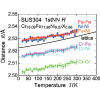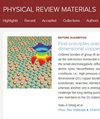Local thermal expansion of Co-containing invar alloys
IF 3.4
3区 材料科学
Q2 MATERIALS SCIENCE, MULTIDISCIPLINARY
引用次数: 0
Abstract
Thermal expansion of Co-containing invar alloys of GX1Ni29-Co17 and stainless invar was investigated from the viewpoint of local structure by analyzing temperature-dependent extended x-ray absorption fine-structure (EXAFS) spectra combined with the computational simulations based on the path-integral effective classical potential (PIECP) method. For detailed comparative discussion, FeNi invar alloys of 36invar, 42invar, and 45invar were also examined. It is found by EXAFS that in stainless invar, Co exhibits a noticeable invar effect, while the invar effect on Co in GX1Ni29-Co17 is negligibly small. The PIECP simulations provide qualitative agreement with this finding, exemplifying that the Co magnetization is more effectively suppressed in stainless invar with a temperature rise, because of a smaller lattice constant and shorter corresponding interatomic distances. The present study clearly demonstrates the importance of the local structural point of view to understand the detailed low thermal expansion mechanism, in which microscopic local thermal expansion often meaningfully differs from macroscopic lattice thermal expansion.

含钴英卡合金的局部热膨胀
通过分析随温度变化的扩展 X 射线吸收精细结构(EXAFS)光谱,并结合基于路径积分有效经典势(PIECP)方法的计算模拟,从局部结构的角度研究了 GX1Ni29-Co17 Fe54Co17Ni29 的含 Co 英卡合金和不锈钢英卡 Fe39Co50Cr9Ni2 的热膨胀。为了进行详细的比较讨论,还研究了 36invar、42invar 和 45invar 的铁镍英卡合金。通过 EXAFS 发现,在不锈金刚石中,钴表现出明显的金刚石效应,而在 GX1Ni29-Co17 中,钴的金刚石效应很小,可以忽略不计。PIECP 模拟与这一发现在本质上是一致的,说明随着温度的升高,不锈钒中的钴磁化会受到更有效的抑制,因为晶格常数更小,相应的原子间距离更短。本研究清楚地表明了从局部结构角度理解详细的低热膨胀机制的重要性,其中微观的局部热膨胀往往与宏观的晶格热膨胀存在有意义的差异。
本文章由计算机程序翻译,如有差异,请以英文原文为准。
求助全文
约1分钟内获得全文
求助全文
来源期刊

Physical Review Materials
Physics and Astronomy-Physics and Astronomy (miscellaneous)
CiteScore
5.80
自引率
5.90%
发文量
611
期刊介绍:
Physical Review Materials is a new broad-scope international journal for the multidisciplinary community engaged in research on materials. It is intended to fill a gap in the family of existing Physical Review journals that publish materials research. This field has grown rapidly in recent years and is increasingly being carried out in a way that transcends conventional subject boundaries. The journal was created to provide a common publication and reference source to the expanding community of physicists, materials scientists, chemists, engineers, and researchers in related disciplines that carry out high-quality original research in materials. It will share the same commitment to the high quality expected of all APS publications.
 求助内容:
求助内容: 应助结果提醒方式:
应助结果提醒方式:


